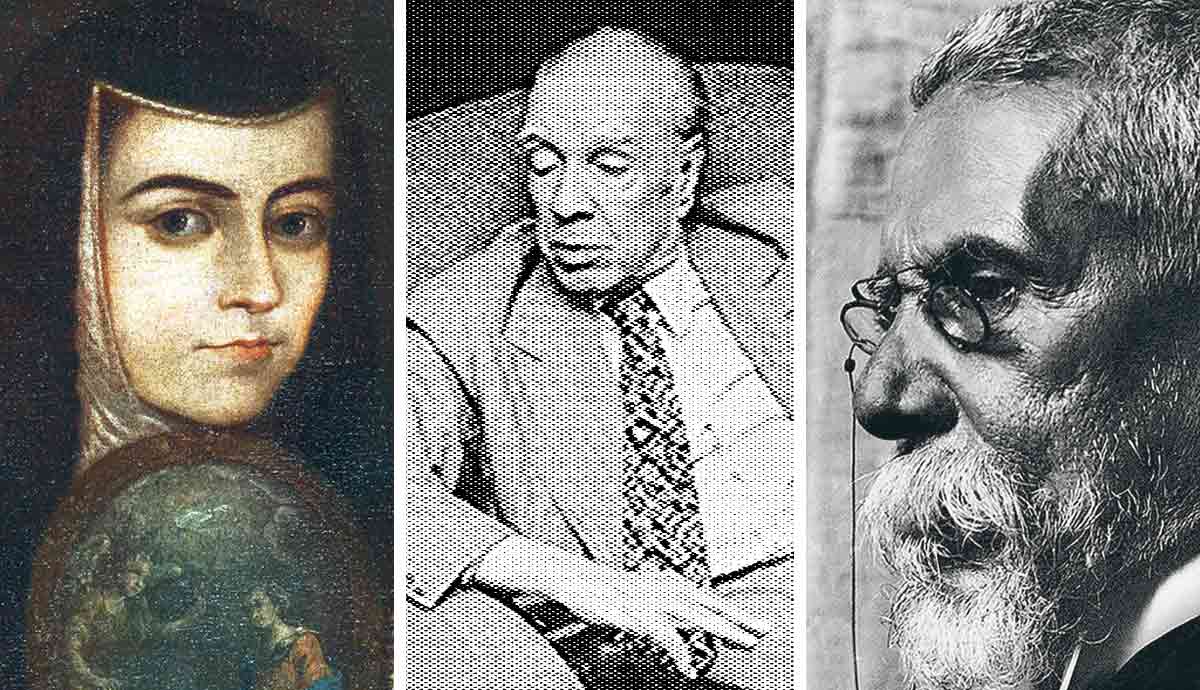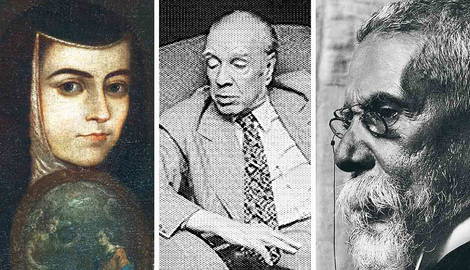
The Boom movement in the mid-20th century marked a literary renaissance in Latin America, drawing global attention to writers from all across the continent. With magical realism at the forefront, literary narratives upended European modes of storytelling, crafting unique narratives that reshaped the world’s perception of Latin American literature and history. While the Latin American Boom was a 20th-century phenomenon, the literary heritage from pre-Columbian times to the colonial era and independence movements cannot be overlooked. Here are six of the greatest Latin American authors to read.
1. Jorge Luís Borges

Argentine Jorge Luís Borges is one of the most well-known writers of Latin America. Born in Buenos Aires in 1899, Borges spent his childhood and adolescence in Europe, returning to Argentina in 1921.
Borges’s poems and collections of short stories, Fictions and “The Aleph” being the best-known, captivate the reader with their infinite curiosity about human existence examined through explorations of theology and philosophy, which Borges claims are the same thing. His stories defy a singular perception of this universe, with their labyrinthine libraries, alternate realities, and the constant blurring between reality and illusion.
Libraries held immense significance for Borges not only in fiction but also in life. In addition to being an avid reader and professor of English literature at the University of Buenos Aires, Borges served as the director of the National Public Library.

He often wove autobiographical details into his stories. “The South” is an excellent illustration of this. The protagonist Juan Dahlmann, who lives an uneventful and quiet life as a librarian in Buenos Aires, just like the author himself, suffers a head injury and starts to reflect on his German ancestry and his ties to the Argentine south in a hospital bed. The story takes the man from Buenos Aires to the country’s south, where a dreamlike reality draws him into a fight with gauchos. The story leaves the reader questioning whether Dahlmann is actually fighting the gauchos or is still in his hospital bed hallucinating a more epic death.
This story is inspired by an episode of septicemia that almost killed Borges. The writer underwent other health challenges throughout his life. Though visually impaired later in life, he never stopped reading and writing. To the surprise and discontent of many, this extraordinary voice of Latin American literature never received a Nobel prize. Nevertheless, Jorge Luís Borges is considered by many to be Latin America’s greatest writer.
2. Gabriela Mistral

In 1945, Gabriela Mistral, a schoolteacher and poet from Chile, became the first Latin American to win the Nobel Prize in literature. The Swedish Academy recognized Mistral “for her lyric poetry which, inspired by powerful emotions, has made her name a symbol of the idealistic aspirations of the entire Latin American world.”
Gabriela Mistral, born Lucila Godoy Alcayaga, drew inspiration for writing from her father, who was also a schoolteacher. Mistral’s early life was marked by grief, as she lost her fiance to suicide, an event that left its imprint in many of her poems.
“Desolación” (“Desolation”), Mistral’s first anthology that explores love, grief, death, and faith with an intimate and evocative language is a testament to Mistral’s deep sensibility as a poet. Children and frustrated maternity are other recurrent themes in Mistral’s poetry. At odds with her political beliefs, her poetry is infused with religious and Catholic themes.
An outspoken socialist, Mistral led a politically and socially active life. Beyond a rich literary heritage, she contributed to school reforms both in Chile and Mexico, advocating for equal access to education for all children. Her love for children and devotion to education are beautifully expressed both in her life’s work and through her body of work.
3. Sor Juana Inés de la Cruz

Sor Juana Inés de la Cruz, Latin America’s most famous nun, stands as a precursor to feminism whose literary legacy transcends time and space. Sor Juana’s unparalleled intellect, talent, and erudition earned her acclaim throughout colonial Latin America and Spain, placing her in the company of literary giants such as Luis de Góngora, Lope de Vega, and Pedro Calderón de la Barca. Her work remains one of the most remarkable examples of Hispanic Baroque literature.
Confronted with the social norms of colonial Mexico, Sor Juana had to make a choice: marriage or convent. In opting for life in the convent, Sor Juana gained social protection and access to an extensive library, where she devoted the majority of her time to scholarly pursuits and writing.
As an outspoken nun and advocate for women’s education, Sor Juana faced persecution throughout her life, often having to confront colonial authorities and church officials. Her essays are filled with witty confrontations, rich in erudition and sarcasm, while her poetry is straightforward and poignant—a testament to her inner turmoil in response to societal norms.
Sor Juana’s love poems—met with criticism and resistance from church authorities—are an expression of her deep connection to her inner world. Many dedicated to the Vicereine of Mexico, María Luisa Manrique de Lara y Gonzaga, attest to an intimate relationship between the two women, prompting speculation about Sor Juana’s potential romantic feelings for María Luisa.
Due to her exploration of feminist themes, Sor Juana’s writing and life have been recently re-examined from a feminist perspective, positing her as an early feminist whose legacy continues to inspire women and writers across Latin America.
4. Gabriel García Márquez

It would not be an exaggeration to say that Gabriel García Márquez is Latin America’s most well-known and read author globally. “Gabo,” as he is often called, became synonymous with magical realism and the Latin American Boom movement of the 1960s.
Gabriel García Márquez was born in Aracataca, Colombia, a municipality in the country’s Caribbean region. The rich cultural folklore and syncretic practices of the Caribbean coast served as a foundation for the creation of Macondo, the fictional town where most of Márquez’s stories are set. Initially pursuing a law degree, Márquez abandoned his studies and began working as a journalist before embarking on a prolific writing career.
Gabo’s most-read novel, One Hundred Years of Solitude—published for the first time in 1967—is the quintessential magical realist novel. Translated into more than 40 languages and with over 45 million copies sold worldwide, it continues to be the most translated literary work in Spanish after Don Quixote. In 1982, Márquez won the Nobel Prize, becoming the epitome of the literary success that swept over Latin America in the second half of the 20th century.
For those who need an introduction to magical realist novels and Latin American literature, Gabriel García Márquez is an excellent point of departure.
5. Joaquim Maria Machado de Assis

Joaquim Maria Machado de Assis, one of Brazil’s greatest writers, lived and wrote in the 19th century. Born to a father of African descent and a white mother of Azorean ancestry, Machado de Assis experienced the contrasting realities of 19th-century Brazil due to his mixed-race heritage. Despite being a pardo, the writer did not explicitly address it in his writings, and his political views remain unknown to critics to this day. As a civil servant, Machado de Assis led a quiet life, dedicating himself to his governmental job until his very last days.
Although Machado de Assis’s writing initially did not garner admiration from literary critics and writers, he is now regarded as one of the most prominent figures in Brazilian literature. Machado is appreciated for his satire and innovative narrative techniques. His novel The Posthumous Memoirs of Brás Cubas recounts the life of Brás Cubas in the first person after the protagonist-narrator announces his own death. The novel delves into themes of betrayal and jealousy through an unreliable narrator.
Two of the most notable features of Machado’s work are ambiguity and unreliable narration—qualities that have piqued the interest of both scholars and readers. One of the writer’s most-read stories, titled “Missa do galo” (“Midnight Mass”), is an excellent example of his use of these devices. In typical Machado fashion, the story leaves the reader questioning whether or not there was adultery between the protagonist and the married landlady.
6. Pablo Neruda

Tonight I can write the saddest lines.
Write, for example, ‘The night is starry and the stars are blue and shiver in the distance.’
These unforgettable lines belong to Pablo Neruda’s most renowned poem. A master of poetic excellence and lyrical prowess, the Chilean writer gained worldwide recognition and acclaim, leading him to win a Nobel Prize in 1971.
Born Ricardo Eliécer Neftalí Reyes Basoalto, Neruda started writing poetry at a very young age. Though discouraged by his father, he continued writing and soon started publishing under the pseudonym Pablo Neruda. As a student, Neruda was encouraged by Gabriela Mistral, who worked as a school principal at the time. Interestingly, both poets went on to become Chile’s Nobel laureates.
A prolific writer, Neruda had two books published by the time he was 20 years old. However, the writer faced poverty in the early years of his career and had to take up low-paying diplomatic jobs to support himself. It was after Neruda developed a friendship with the Spanish poet Federico García Lorca and relocated to Spain as a consul that his poetry became more widely known and accepted in larger artistic circles.
Neruda’s literary legacy is immense and too diverse to be summarized in a single paragraph. It is safe to say, however, that Twenty Love Poems and a Song of Despair is his best-known masterpiece and one of the most celebrated collections of love poems ever written.










